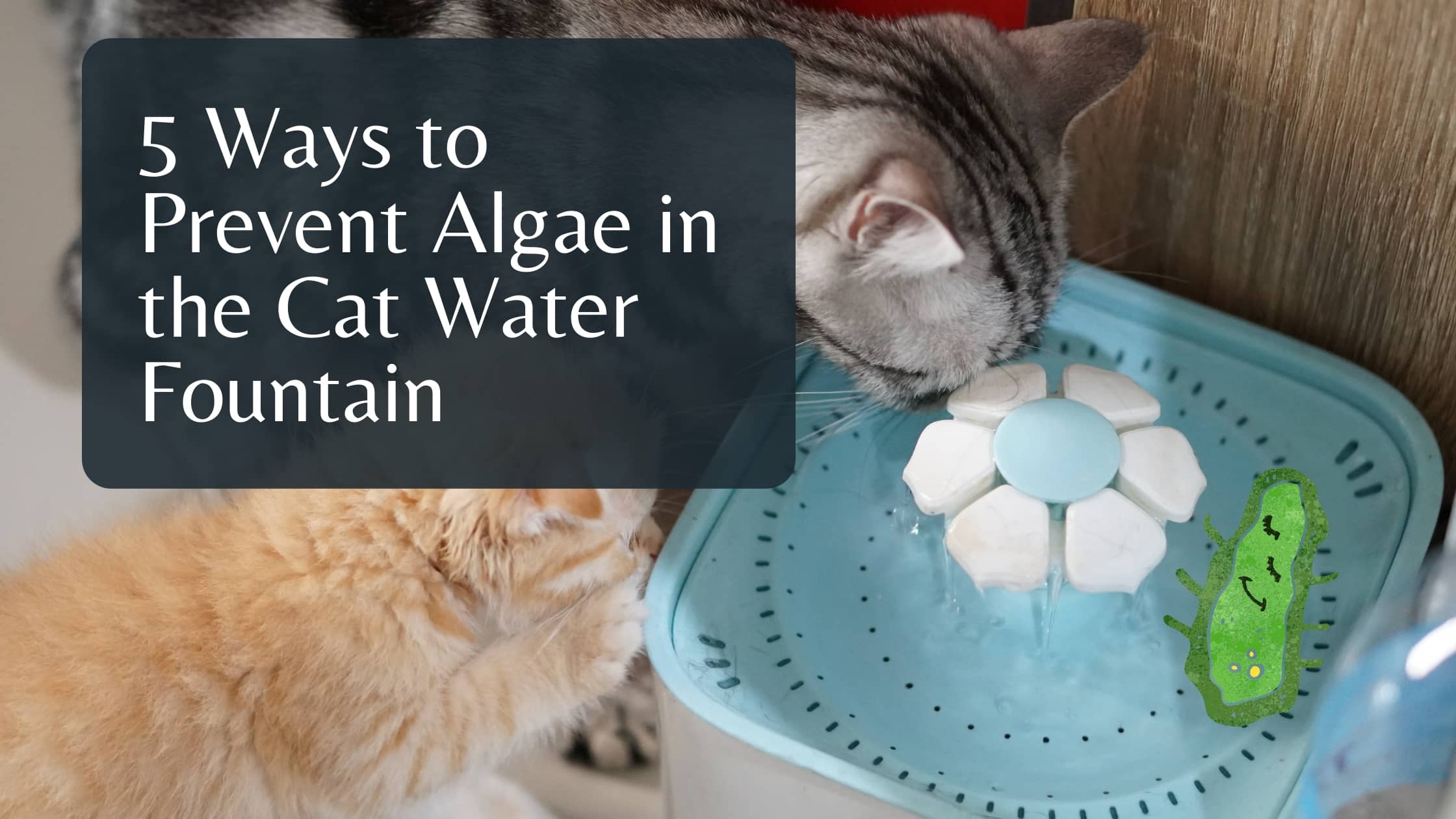As a cat owner, you know the importance of keeping your furry friend’s water bowl clean and fresh. But what happens when you start to notice green or brown slime growing in the bowl? This is a common problem that many pet owners face – algae growth. Not only is it unsightly, but it can also be harmful to your cat’s health. In this article, we will explore ways to prevent algae from growing in your cat’s water bowl and ensure that they always have access to clean and safe drinking water.
Algae growth in your cat’s water bowl is a result of light, warmth, and stagnant water. Without proper care, algae can quickly take over your cat’s water bowl, leading to an unsanitary drinking environment. Fortunately, there are several simple and effective ways to prevent algae from growing in the first place. From regular cleaning to strategic placement of the water bowl, we’ve got you covered. Keep reading to learn how to keep your cat’s water bowl algae-free and your furry friend healthy and hydrated.
- Keep the water bowl in a shaded area, as sunlight promotes algae growth.
- Use a ceramic or stainless-steel bowl, as plastic bowls can scratch easily and provide crevices for algae to grow.
- Change the water frequently, at least once a day, and clean the bowl thoroughly each time.
- Consider using a water fountain for cats, as the constant flow of water can prevent algae growth.

**How to Keep Algae From Growing in Cat Water Bowl?**
Cats are wonderful pets, and keeping them hydrated is important for their overall health. However, one of the challenges that cat owners face is keeping their water bowl clean and free from algae growth. Algae can not only make the water unappetizing for cats, but it can also be harmful to their health if consumed. In this article, we will discuss effective ways to keep algae from growing in your cat’s water bowl.
**1. Clean the Water Bowl Regularly**
The first step to preventing algae growth in your cat’s water bowl is to clean it regularly. Ideally, you should clean the water bowl every day or at least every other day. Use warm soapy water and a soft-bristled brush to scrub the bowl thoroughly. Rinse it well with clean water to remove any traces of soap. This will not only prevent algae growth but also keep the bowl free from bacteria and other harmful microorganisms.
Another option is to use a dishwasher to clean the water bowl. However, make sure that the bowl is dishwasher safe before putting it in the dishwasher. Also, avoid using harsh chemicals or detergents that can leave behind residues that may be harmful to your cat.
**2. Use a Ceramic or Stainless-Steel Bowl**
Choosing the right material for your cat’s water bowl can also help prevent algae growth. Ceramic and stainless-steel bowls are excellent choices because they are non-porous and do not have any small cracks or crevices where bacteria and algae can grow. They are also easy to clean and maintain, making them ideal for cat owners who want to keep their cat’s water bowl clean and hygienic.
**3. Keep the Water Bowl Out of Direct Sunlight**
Algae thrive in warm, sunny environments, so keeping your cat’s water bowl out of direct sunlight can also help prevent algae growth. Choose a shaded area in your home where the bowl can be placed, away from windows and other sources of direct sunlight. This will not only prevent algae growth but also keep the water cooler and fresher for your cat.
**4. Change the Water Frequently**
Changing the water frequently is another effective way to prevent algae growth in your cat’s water bowl. Algae grow in stagnant water, so make sure to change the water at least once a day, preferably twice a day. This will also ensure that your cat has access to fresh, clean water at all times.
**5. Use a Water Fountain**
Using a water fountain is another option that can help prevent algae growth in your cat’s water bowl. Water fountains circulate the water, keeping it moving and aerated, which makes it difficult for algae to grow. They also provide a constant source of fresh, clean water for your cat, which can encourage them to drink more water.
**6. Add a Few Drops of Vinegar to the Water**
Adding a few drops of vinegar to your cat’s water can also help prevent algae growth. Vinegar is a natural disinfectant that can kill bacteria and other harmful microorganisms in the water. However, make sure to use only a small amount of vinegar, as too much can make the water unpalatable for your cat.
**7. Use a Water Additive**
There are water additives available in the market that can help prevent algae growth in your cat’s water bowl. These additives are safe for cats and can be added directly to the water. They work by changing the pH of the water, making it less hospitable for algae to grow. However, make sure to follow the instructions carefully and use only the recommended amount.
**8. Avoid Using Plastic Bowls**
Plastic bowls are not recommended for cat water bowls because they can harbor bacteria and other harmful microorganisms. They are also prone to scratches and cracks, which can provide a breeding ground for algae. If you must use a plastic bowl, make sure to replace it frequently and clean it thoroughly.
**9. Keep the Water Bowl Elevated**
Elevating the water bowl can also help prevent algae growth. Algae need a flat surface to grow, and elevating the bowl can prevent the water from becoming stagnant. You can use a raised feeder or simply place the bowl on a sturdy platform.
**10. Monitor Your Cat’s Water Intake**
Finally, it is essential to monitor your cat’s water intake. Cats need to drink enough water to stay hydrated and maintain their overall health. If you notice that your cat is not drinking enough water, try changing the water bowl or using a water fountain. You can also try adding a few drops of tuna water or chicken broth to the water to make it more appealing to your cat.
In conclusion, keeping your cat’s water bowl clean and free from algae growth is essential for their health and well-being. By following these simple tips, you can ensure that your cat has access to fresh, clean water at all times. Remember to clean the water bowl regularly, choose the right material, keep the bowl out of direct sunlight, change the water frequently, use a water fountain or additive, avoid plastic bowls, elevate the water bowl, and monitor your cat’s water intake.
Frequently Asked Questions
Algae growth in a cat’s water bowl is a common problem. Here are some frequently asked questions and their answers about how to keep algae from growing in a cat water bowl.
What causes algae to grow in a cat water bowl?
Algae growth in a cat’s water bowl is caused by a combination of factors including sunlight, warm temperatures, and stagnant water. The sunlight and warmth create the perfect environment for algae to grow, and the stagnant water provides the algae with the nutrients it needs to thrive.
The nutrients in the water can come from a variety of sources, including food particles left in the bowl, saliva from the cat, and any other debris that may have fallen into the water. The longer the water sits in the bowl, the more time the algae has to grow.
How often should I clean my cat’s water bowl to prevent algae growth?
It is recommended that you clean your cat’s water bowl at least once a day to prevent algae growth. If you notice any algae in the bowl, you should clean it immediately. Use a mild detergent and warm water to scrub the bowl thoroughly, and rinse it well with clean water.
Make sure to dry the bowl completely before refilling it with fresh water. This will help prevent any remaining algae spores from growing and contaminating the new water.
Are there any natural remedies for preventing algae growth in a cat water bowl?
Yes, there are several natural remedies you can use to prevent algae growth in your cat’s water bowl. One option is to add a few drops of apple cider vinegar to the water. This will help lower the pH of the water, making it less hospitable for algae to grow.
Another option is to add a small amount of baking soda to the water. This will help neutralize the pH of the water, making it less hospitable for algae to grow. You can also try adding a few drops of grapefruit seed extract to the water. This natural disinfectant can help prevent the growth of algae and other bacteria in the water.
Can I use bleach to clean my cat’s water bowl?
While bleach can be an effective cleaning agent, it is not recommended for cleaning your cat’s water bowl. Bleach can be toxic to cats if ingested, and even small amounts can cause serious health problems. Instead, use a mild detergent and warm water to clean the bowl, and rinse it well with clean water.
If you do decide to use bleach, make sure to dilute it thoroughly and rinse the bowl well with clean water. Let the bowl air dry completely before refilling it with fresh water.
What type of water bowl is best for preventing algae growth?
The best type of water bowl for preventing algae growth is one that is made of stainless steel, ceramic, or glass. These materials are non-porous, which means they are less likely to harbor bacteria and other organisms that can contribute to algae growth.
Avoid using plastic bowls, as they can scratch easily and provide a breeding ground for bacteria and other organisms. If you must use a plastic bowl, make sure to clean it thoroughly and replace it regularly to prevent the buildup of bacteria and other contaminants.

In conclusion, keeping algae from growing in your cat’s water bowl is crucial for their health and well-being. Algae can lead to various health problems and even decrease your cat’s water intake. By following the tips mentioned above, you can prevent algae growth and provide your cat with clean and fresh water all the time.
In summary, the key to preventing algae growth is to clean the bowl regularly, change the water frequently, and keep the bowl away from direct sunlight. These simple steps can go a long way in ensuring your cat’s health and happiness.
Lastly, as a cat owner, it’s your responsibility to provide your furry friend with the best possible care. Ensuring that their water bowl is clean and free of algae is just one way to show your love and commitment to their well-being. So, take the necessary steps to keep your cat’s water bowl algae-free and enjoy a happy and healthy cat.
